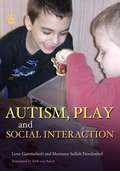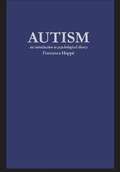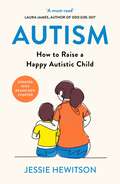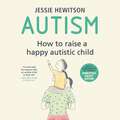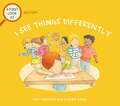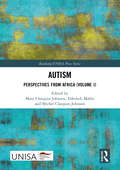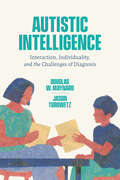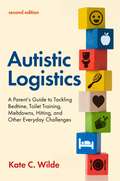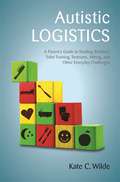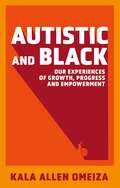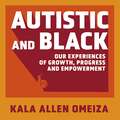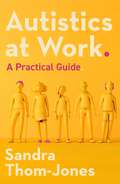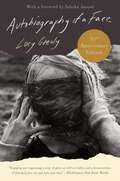- Table View
- List View
Autism, Play and Social Interaction
by Marianne Sollok Nordenhof Lone GammeltoftAutism, Play and Social Interaction is a fully illustrated guide that explains how to help children with autism spectrum disorders engage in interactive play, which is vital for the acquisition of social skills and attention to shared activities. The authors explain how to set up suitably structured play environments, games schedules and play routines, and how to use visual aids and other props to facilitate co-operative play and interaction. Common children's games have been adapted to accommodate children with autism spectrum disorders and range from simple interaction, such as `putting-in' and `give and take', to more complex games like `hide and seek', `sound-lotto' and `spin the bottle', as well as games that teach social behaviour, such as exchanging toys and engaging with other children for play opportunities. This is a practical and accessible book for parents and teachers of children with autism spectrum disorders, as well as professionals working with these children.
Autism, the Invisible Cord: A Sibling's Diary
by Barbara CainEzra looks like any other sixth grader with faded jeans, turned around the cap, and a mess of chestnut curls. You see, my brother is like any other eleven-year-old...except when he isn't. <p><p>Autism, The Invisible Cord follows 14-year-old Jenny as she describes her day-to-day life with her younger autistic brother, Ezra. Ezra can be both her best friend as well as her biggest obstacle to living a "normal life," and Jenny often finds herself stuck worrying about her younger brother. Through taking care of Ezra and a very special school project, Jenny ends up learning about her own character and strengths, and a way to shine despite everything else.
Autism: A Holistic View
by Regina Varin-MignanoMuch of the recent research in autism comes from a quantitative, researcher's viewpoint. However, this book's mission is to look at the "whole picture" in order to capture the meaning of Autism and its effects on the family. The book is written primarily for social work professionals in the field of autism and developmental disabilities, Students, individuals affected with Autism Spectrum Disorders and their families alike, and anyone who has a special interest in the ASD field. In order to capture the impact of autism, the autor utilizes her own personal and professional experience in identifying the different aspects that make up the culture of autism: its history, the biological and environmental aspects; past and present governmental and educational policies; the social impact of autism and its impact on the family unit.
Autism: A practical guide for families and professionals
by Paul Whiteley Mark Earnden Elouise RobinsonAutism represents one of the biggest health challenges facing children today. Whilst experts around the globe strive to unravel and truly understand how autism develops and presents itself, relatively little is still known about the condition. Meanwhile, strong evidence has emerged that the diet in children on the autistic spectrum can have a significant role to play in the management of their symptoms. A growing body of research reveals that some challenging characteristics present in autism may be positively affected by the introduction of a gluten- and casein-free (GFCF) diet. Autism: Exploring the benefits of a gluten and casein free diet offers an easy-to-read alternative to sifting through the science. Written by experts in autism research, food, nutrition and dietetics, the book cuts through the science-speak to offer readers a no-nonsense overview of diet and autism together with a range of useful recipes and handy hints for making mealtimes fun for children with autism and related conditions.
Autism: An Introduction to Psychological Theory
by Francesca Happe Sue Fletcher-WatsonThis title is intended for advanced undergraduate and masters level students in psychology; professional clinical, developmental and educational psychologists; general practitioners and others with a special interest in children; careworkers; and parents of autistic children.
Autism: Educational and Therapeutic Approaches
by Efrosini KalyvaThere are a number of different approaches and therapies available for children, young people and adults on the autistic spectrum, and the amount of information available on each one can be daunting for professionals and parents alike. This book offers concise and clear explanations of a variety of proposed interventions and their effectiveness, and helps the reader to decide on the most appropriate treatment for each individual. Efrosini Kalyva writes accessibly about recent scientific evidence and the latest research, and allows you to consider the pros and cons of each approach. She focuses on the following areas: - cognitive-behavioural approaches - developing social interaction - alternative communication strategies - developing play - sensory-motor approaches - psychotherapeutic approaches - biochemical approaches This much-needed guide for practitioners and student teachers will also appeal to interested parents, and to anyone looking for a comparative examination of the variety of treatments on offer.
Autism: How to raise a happy autistic child
by Jessie Hewitson'A wise SatNav for what is often a bewildering, or even scary, zone of parenting. The book offers real-world, road-tested, child-first and family-friendly advice; while also highlighting the twin truths that autism is not a tragedy, and that adaptation and acceptance are not resignation' David Mitchell, bestselling author and co-translator of The Reason I Jump'A must-read for anyone with an autistic child in their life' Laura James, author of Odd Girl OutWritten by Jessie Hewitson, an award-winning journalist at The Times, Autism is the book she wishes she had read when her son was first given the diagnosis of autism spectrum disorder.It combines her own experiences with tips from autistic adults, other parents - including author David Mitchell - as well as advice from autism professionals and academics such as Professor Simon Baron-Cohen. Autism looks at the condition as a difference rather than a disorder and includes guidance on:· What to do if you think your child is autistic · How to understand and support your child at school and at home · Mental health and autism · The differences between autistic girls and boys'It is incredibly useful and informative, full of new research and interviews that put right an awful lot of misinformation. I cannot recommend this highly enough' The Sun'Exceptionally useful and informative' Uta Frith, Emeritus Professor of Cognitive Development, UCL
Autism: How to raise a happy autistic child
by Jessie Hewitson'A wise SatNav for what is often a bewildering, or even scary, zone of parenting. The book offers real-world, road-tested, child-first and family-friendly advice; while also highlighting the twin truths that autism is not a tragedy, and that adaptation and acceptance are not resignation' David Mitchell, bestselling author and co-translator of The Reason I Jump'A must-read for anyone with an autistic child in their life' Laura James, author of Odd Girl OutWritten by Jessie Hewitson, an award-winning journalist at The Times, Autism is the book she wishes she had read when her son was first given the diagnosis of autism spectrum disorder.It combines her own experiences with tips from autistic adults, other parents - including author David Mitchell - as well as advice from autism professionals and academics such as Professor Simon Baron-Cohen. Autism looks at the condition as a difference rather than a disorder and includes guidance on:· What to do if you think your child is autistic · How to understand and support your child at school and at home · Mental health and autism · The differences between autistic girls and boys'It is incredibly useful and informative, full of new research and interviews that put right an awful lot of misinformation. I cannot recommend this highly enough' The Sun'Exceptionally useful and informative' Uta Frith, Emeritus Professor of Cognitive Development, UCL
Autism: How to raise a happy autistic child
by Jessie Hewitson'A wise SatNav for what is often a bewildering, or even scary, zone of parenting. The book offers real-world, road-tested, child-first and family-friendly advice; while also highlighting the twin truths that autism is not a tragedy, and that adaptation and acceptance are not resignation' David Mitchell, bestselling author and co-translator of The Reason I Jump'A must-read for anyone with an autistic child in their life' Laura James, author of Odd Girl OutThe definitive guide for parents of autisic children, written from the perspective of neurodiversity. Written by Jessie Hewitson, an award-winning journalist at The Times, Autism is the book she wishes she had read when her son was first given the diagnosis of autism spectrum disorder.It combines her own experiences with tips from autistic adults, other parents - including author David Mitchell - as well as advice from autism professionals and academics such as Professor Simon Baron-Cohen. Autism looks at the condition as a difference rather than a disorder and includes guidance on:· What to do if you think your child is autistic · How to understand and support your child at school and at home · Mental health and autism · The differences between autistic girls and boys'Jessie Hewitson has really hit the mark with this book, giving our history, our diversity, our challenges and our hopes. Autistic people and their families are finally represented' Carrie Grant'Exceptionally useful and informative' Uta Frith, Emeritus Professor of Cognitive Development, UCLRead by Lucy Scott(p) Orion Publishing Group 2018
Autism: I See Things Differently (A First Look At #29)
by Pat ThomasThis reassuring picture book explains what autism is in simple terms, helping children with siblings or classmates with autism understand what everyday life feels like from a child with autism's perspective.The superb A First Look At series consists of a number of reassuring picturebooks that give advice and promote interaction between children, parents, and teachers on a wide variety of personal, social and emotional issues. Notes for parents and teachers at the back of the book provide valuable advice for how to share this book with your child or class. Suitable for Key Stage 1 (ages 5-7), occasional prompts throughout the text give a chance to discuss the issue being raised. Written by trained psychotherapist, journalist and parent, and illustrated by an experienced children's book artist, this is a part of an acclaimed and successful, long-running series of picture-book non-fiction books for Early Years. Books in the series give advice and promote interaction between children, parents and teachers on a wide variety of personal, social and emotional issues. They are excellent tools for teachers to use during classroom discussions.
Autism: Perspectives from Africa (Volume I) (Routledge/UNISA Press Series)
by Dikeledi Mahlo Mary Clasquin-Johnson Michel Clasquin-JohnsonThis book is written at a time of a paradigm shift in the African continent where dependence on western epistemologies and ontologies are giving way to African indigenous knowledge systems. Africa has been an importer of knowledge from the west since time immemorial and this book contributes to the body of knowledge on autism spectrum disorder (ASD) from the African perspective. As a result, decoloniality and Inclusive Education have gained traction within the academic discourse, with University of South Africa (UNISA) hosting decoloniality annual conference and a summer school to stimulate academic discussions and debates with a focus on African indigenous knowledge systems and theoretical lenses as opposed to the western epistemologies. The book also demystifies some of the misconceptions that children with ASD are a curse and punishment from God or gods. Among others, Ubuntu seems to be the dominant theoretical framework underpinning some of the research studies reported in this book.
Autism: The Science of Mental Health (The Science of Mental Health #2)
by Steven HymanThe Science of Mental Health: Volume 2: Autism by Steven Hyman
Autistic Community and the Neurodiversity Movement: Stories from the Frontline
by Steven K. KappThis open access book marks the first historical overview of the autism rights branch of the neurodiversity movement, describing the activities and rationales of key leaders in their own words since it organized into a unique community in 1992. Sandwiched by editorial chapters that include critical analysis, the book contains 19 chapters by 21 authors about the forming of the autistic community and neurodiversity movement, progress in their influence on the broader autism community and field, and their possible threshold of the advocacy establishment. The actions covered are legendary in the autistic community, including manifestos such as “Don’t Mourn for Us”, mailing lists, websites or webpages, conferences, issue campaigns, academic project and journal, a book, and advisory roles. These actions have shifted the landscape toward viewing autism in social terms of human rights and identity to accept, rather than as a medical collection of deficits and symptoms to cure.
Autistic Disturbances: Theorizing Autism Poetics from the DSM to Robinson Crusoe (Corporealities: Discourses Of Disability)
by Julia M RodasWhile research on autism has sometimes focused on special talents or abilities, autism is typically characterized as impoverished or defective when it comes to language. Autistic Disturbances reveals the ways interpreters have failed to register the real creative valence of autistic language and offers a theoretical framework for understanding the distinctive aesthetics of autistic rhetoric and semiotics. Reinterpreting characteristic autistic verbal practices such as repetition in the context of a more widely respected literary canon, Julia Miele Rodas argues that autistic language is actually an essential part of mainstream literary aesthetics, visible in poetry by Walt Whitman and Gertrude Stein, in novels by Charlotte Brontë and Daniel Defoe, in life writing by Andy Warhol, and even in writing by figures from popular culture. Autistic Disturbances pursues these resonances and explores the tensions of language and culture that lead to the classification of some verbal expression as disordered while other, similar expression enjoys prized status as literature. It identifies the most characteristic patterns of autistic expression-repetition, monologue, ejaculation, verbal ordering or list-making, and neologism-and adopts new language to describe and reimagine these categories in aesthetically productive terms. In so doing, the book seeks to redress the place of verbal autistic language, to argue for the value and complexity of autistic ways of speaking, and to invite recognition of an obscured tradition of literary autism at the very center of Anglo-American text culture.
Autistic Intelligence: Interaction, Individuality, and the Challenges of Diagnosis
by Douglas W. Maynard Jason TurowetzAn examination of diagnostic processes that questions how we can better understand autism as a category, recognizing its intelligence and uncommon sense. As autism has become a widely prevalent diagnosis, we have grown increasingly desperate to understand it. Whether by placing unfounded blame on vaccines or seeking a genetic cause, Americans have struggled to understand what autism is and where it comes from. Amid these efforts, however, a key aspect of autism has been largely overlooked: the diagnostic process itself. The authors of Autistic Intelligence ask us to question the norms we use to measure autistic behavior, to probe how autistic behavior can be considered sensible rather than disordered, and to explore how we can better appreciate the individuality of those who receive the diagnosis. Drawing on hundreds of hours of video recordings and ethnographic observations at a clinic where professionals evaluate children for autism, the authors’ analysis of interactions among clinicians, parents, and children demystifies the categories, tools, and practices involved in the diagnostic process. Autistic Intelligence shows that autism is not a stable category, but the outcome of complex interacting processes involving professionals, children, families, and facets of the social and clinical environments they inhabit. The authors suggest that diagnosis, in addition to carefully classifying children, also can highlight or include unique contributions those with autism make to the world around us.
Autistic Intelligence: Interaction, Individuality, and the Challenges of Diagnosis
by Douglas W. Maynard Jason TurowetzAn examination of diagnostic processes that questions how we can better understand autism as a category, recognizing its intelligence and uncommon sense. As autism has become a widely prevalent diagnosis, we have grown increasingly desperate to understand it. Whether by placing unfounded blame on vaccines or seeking a genetic cause, Americans have struggled to understand what autism is and where it comes from. Amid these efforts, however, a key aspect of autism has been largely overlooked: the diagnostic process itself. The authors of Autistic Intelligence ask us to question the norms we use to measure autistic behavior, to probe how autistic behavior can be considered sensible rather than disordered, and to explore how we can better appreciate the individuality of those who receive the diagnosis. Drawing on hundreds of hours of video recordings and ethnographic observations at a clinic where professionals evaluate children for autism, the authors’ analysis of interactions among clinicians, parents, and children demystifies the categories, tools, and practices involved in the diagnostic process. Autistic Intelligence shows that autism is not a stable category, but the outcome of complex interacting processes involving professionals, children, families, and facets of the social and clinical environments they inhabit. The authors suggest that diagnosis, in addition to carefully classifying children, also can highlight or include unique contributions those with autism make to the world around us.
Autistic Intelligence: Interaction, Individuality, and the Challenges of Diagnosis
by Douglas W. Maynard Jason TurowetzAn examination of diagnostic processes that questions how we can better understand autism as a category, recognizing its intelligence and uncommon sense. As autism has become a widely prevalent diagnosis, we have grown increasingly desperate to understand it. Whether by placing unfounded blame on vaccines or seeking a genetic cause, Americans have struggled to understand what autism is and where it comes from. Amid these efforts, however, a key aspect of autism has been largely overlooked: the diagnostic process itself. The authors of Autistic Intelligence ask us to question the norms we use to measure autistic behavior, to probe how autistic behavior can be considered sensible rather than disordered, and to explore how we can better appreciate the individuality of those who receive the diagnosis. Drawing on hundreds of hours of video recordings and ethnographic observations at a clinic where professionals evaluate children for autism, the authors’ analysis of interactions among clinicians, parents, and children demystifies the categories, tools, and practices involved in the diagnostic process. Autistic Intelligence shows that autism is not a stable category, but the outcome of complex interacting processes involving professionals, children, families, and facets of the social and clinical environments they inhabit. The authors suggest that diagnosis, in addition to carefully classifying children, also can highlight or include unique contributions those with autism make to the world around us.
Autistic Logistics, Second Edition: A Parent's Guide to Tackling Bedtime, Toilet Training, Meltdowns, Hitting, and Other Everyday Challenges
by Kate WildeHave you ever wished there was a manual for parenting children on the autism spectrum? This book provides just that, offering clear, precise, step-by-step advice on everything you want to know, including: - How to toilet train your child without pushing or pressuring- How to get your child to sleep in their own bed and through the night- What to do when your child misbehaves/ lashes out, hits or bites- How to introduce new foods without a fightThis updated edition is based on Kate Wilde's decades of experience and the latest autism research. Tackling a wide range of common parenting milestones, the book offers tried-and-tested techniques to help you transform the challenges of home life and create harmony. Catering to all age ranges and points on the spectrum, this book will be invaluable to parents, caregivers, teachers and teaching assistants.
Autistic Logistics: A Parent's Guide to Tackling Bedtime, Toilet Training, Tantrums, Hitting, and Other Everyday Challenges
by Kate WildeHave you ever wished that your child with autism spectrum disorder (ASD) came with a manual? This book provides just that, offering clear, precise, step-by-step advice on everything you want to know, including: - How to toilet train your child without pushing or pressuring - How to get your child to sleep in their own bed and through the night - What to do when your child tantrums, hits or bites - How to introduce new foods, without a fight Based on decades of experience, Kate Wilde tackles these day-to-day issues and more, using tried-and-tested techniques to help you transform the challenges of home life and create harmony. The unique approach featured in the book, which encourages you to support your child's need for control rather than fight against it, can have transformative results. Not only will you learn to see through your child's eyes and help your child in a way that honors his/her specialness, but you will also begin to free yourself from the pressure and discomfort that can so often accompany everyday challenges. Catering to all age ranges and points on the spectrum, this book will be of immeasurable value to parents and caregivers of children with autism, other family members, as well as teachers and teaching assistants.
Autistic Planet
by Marc Thomas Jennifer ElderAutistic Planet is a magical world where all trains run exactly to time, where people working in offices have rocking chairs, and where all kids dream of winning the chess World Cup. Join us on a journey to this alternative reality, where being different is ordinary, and being "typical" is unheard of! Full of colour illustrations and written in child-friendly rhyme, this book is ideal for children aged 6 and over. Jennifer Elder is assistant editor in a book publishing company. She and her husband have two sons, one of whom has ASD. You can read more about their family in the memoirs Sixpence House and Not Even Wrong. Jennifer is the author of Different Like Me: My Book of Autism Heroes, also published by Jessica Kingsley Publishers.
Autistic Spectrum Disorders: Practical Strategies for Teachers and Other Professionals
by Northumberland County Council Communication Support Services, UKThis book offers helpful categorization of problem areas, solutions that allow teachers to help children promptly and effectively, advice on setting IEP targets, and photocopiable resources.
Autistic and Black: Our Experiences of Growth, Progress and Empowerment
by Kala Allen Omeiza"It's time we bring forward Black autistic pain points and celebrate the triumphs of ourselves, family members, and organizations that care for these individuals. Through following the real stories of others from around the world, I hope fellow Black and autistic individuals will be empowered to realize that being Black and autistic is enough."In this powerful insight into the lives of Black autistic people, Kala Allen Omeiza brings together a community of voices from across the world, spanning religions, sexuality and social economic status to provide a deep and rich understanding of what it means to be autistic and Black.Exploring everything from self-love and appreciation, to the harsh realities of police brutality, anti-Black racism, and barriers to care, as well as amplifying the voices of the inspiring advocates who actively work towards change, protection, and acceptance for themselves and others, this book is an empowering force, reminding you that as a Black autistic person, you are enough.
Autistic and Black: Our Experiences of Growth, Progress and Empowerment
by Kala Allen Omeiza"It's time we bring forward Black autistic pain points and celebrate the triumphs of ourselves, family members, and organizations that care for these individuals. Through following the real stories of others from around the world, I hope fellow Black and autistic individuals will be empowered to realize that being Black and autistic is enough."In this powerful insight into the lives of Black autistic people, Kala Allen Omeiza brings together a community of voices from across the world, spanning religions, sexuality and social economic status to provide a deep and rich understanding of what it means to be autistic and Black.Exploring everything from self-love and appreciation, to the harsh realities of police brutality, anti-Black racism, and barriers to care, as well as amplifying the voices of the inspiring advocates who actively work towards change, protection, and acceptance for themselves and others, this book is an empowering force, reminding you that as a Black autistic person, you are enough.
Autistics at Work: A Practical Guide
by Sandra Thom-JonesSandra Thom-Jones has tried all kinds of work—selling flowers, tending bar, office work, university leadership. Along the way she has made some mistakes, had some successes, and learnt a lot about the barriers and facilitators for autistic people building a career in a predominantly neurotypical work environment. Thom-Jones shares her personal experiences and reflections as well as those of her colleagues, providing insights into the challenges and benefits of both being and working with an autistic employee, co-worker and employer. Autistics at Work is also informed by two decades of study into the autistic experience, and covers all aspects of the employment journey, from entering the workforce to senior leadership. Autistics at Work is essential reading for autistic individuals who are in, or considering entering, the workforce. It is also an invaluable resource for managers, colleagues, employers and employment professionals. This accessible guide includes tools and activities, and each chapter concludes with practical advice for autistic employees and their non-autistic colleagues and employers. We shouldn&’t be asking what jobs are suitable for autistic people, but how can we make this job suitable for this autistic person?
Autobiography of a Face [Thirtieth Anniversary Edition]
by Lucy Grealy”So many memoirs make you feel that you’ve been sealed up inside a wall with a monomaniac. A really good one, like Autobiography of a Face, makes you feel there is more to ask and learn. You are not just seeing the writer; you are not trying to see yourself. You are seeing the world in a different way.”—Margo JeffersonForeword by Suleika Jaouad, author of the New York Times bestseller Between Two KingdomsA thirtieth-anniversary edition of Lucy Grealy’s celebrated memoir, a timeless exploration of identity, loneliness, the nature of beauty, and strength.Thirty years ago, Lucy Grealy’s Autobiography of a Face launched the young writer into the top echelons of contemporary literature, winning her both acclaim and fame. An incandescent tale of perseverance, humor, and deep introspection in the face of emotional and physical pain, her powerful memoir—as evocative and resonant today as it was in 1994—speaks to us across time.At age nine, Lucy Grealy was diagnosed with Ewing’s sarcoma, a potentially terminal cancer, undergoing years of chemotherapy that destroyed a third of her jawbone. When she eventually returned to school, she faced the cruel taunts of classmates. It took her twenty years of living with a distorted self-image and more than thirty years of reconstructive procedures before she began to come to terms with her appearance. This beautiful and timeless memoir is a tale of great suffering and remarkable strength told without sentimentality and with considerable wit. Grealy reflects on how cancer transformed her face and her life, and captures what it was like as a child and a young adult to be torn between wanting to be loved for who we are and desperately wishing to be perfect.
